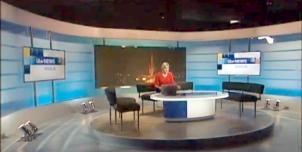Full Freeview on the Tacolneston (Norfolk, England) transmitter
| Google Streetview | Google map | Bing map | Google Earth | 52.518,1.139 or 52°31'6"N 1°8'22"E | NR16 1DW |
The symbol shows the location of the Tacolneston (Norfolk, England) transmitter which serves 330,000 homes. The bright green areas shown where the signal from this transmitter is strong, dark green areas are poorer signals. Those parts shown in yellow may have interference on the same frequency from other masts.
This transmitter has no current reported problems
The BBC and Digital UK report there are no faults or engineering work on the Tacolneston (Norfolk, England) transmitter._______
Digital television services are broadcast on a multiplexes (or Mux) where many stations occupy a single broadcast frequency, as shown below.
64QAM 8K 3/4 27.1Mb/s DVB-T MPEG2
DTG-12 QSPK 8K 3/4 8.0Mb/s DVB-T MPEG2
H/V: aerial position (horizontal or vertical)
Which Freeview channels does the Tacolneston transmitter broadcast?
If you have any kind of Freeview fault, follow this Freeview reset procedure first.Digital television services are broadcast on a multiplexes (or Mux) where many stations occupy a single broadcast frequency, as shown below.
64QAM 8K 3/4 27.1Mb/s DVB-T MPEG2
DTG-12 QSPK 8K 3/4 8.0Mb/s DVB-T MPEG2
H/V: aerial position (horizontal or vertical)
Which BBC and ITV regional news can I watch from the Tacolneston transmitter?

BBC Look East (East) 0.8m homes 3.2%
from Norwich NR2 1BH, 16km northeast (37°)
to BBC East region - 27 masts.
70% of BBC East (East) and BBC East (West) is shared output

ITV Anglia News 0.8m homes 3.2%
from NORWICH NR1 3JG, 16km northeast (38°)
to ITV Anglia (East) region - 26 masts.
All of lunch, weekend and 80% evening news is shared with Anglia (West)
Are there any self-help relays?
| Gt Yarmouth | Transposer | 1 km S town centre | 30 homes |
| Lowestoft (2) | Transposer | Rotterdam Rd | 125 homes |
How will the Tacolneston (Norfolk, England) transmission frequencies change over time?
| 1950s-80s | 1984-97 | 1997-98 | 1998-2011 | 2011-13 | 2013-18 | 2013-17 | 17 Jul 2018 | ||
| VHF | C/D E | C/D E | C/D E | E | E T | W T | W T | ||
| C3 | BBCtvwaves | ||||||||
| C31 | com7 | com7 | |||||||
| C32 | _local | ||||||||
| C37 | com8 | com8 | |||||||
| C39 | +ArqB | +ArqB | ArqB | ||||||
| C40 | BBCA | ||||||||
| C42 | SDN | SDN | SDN | SDN | |||||
| C43 | D3+4 | ||||||||
| C45 | ArqA | ArqA | ArqA | ArqA | |||||
| C46 | BBCB | ||||||||
| C50tv_off | BBCB | BBCB | |||||||
| C52tv_off | C5waves | C5waves | |||||||
| C55tv_off | BBC2waves | BBC2waves | BBC2waves | -BBCA | -BBCA | -BBCA | com7tv_off | ||
| C56tv_off | COM8tv_off | ||||||||
| C57tv_off | LNR | LNR | |||||||
| C59tv_off | ITVwaves | ITVwaves | ITVwaves | -D3+4 | -D3+4 | -D3+4 | |||
| C62 | BBC1waves | BBC1waves | BBC1waves | BBCB | |||||
| C65 | C4waves | C4waves | C4waves |
tv_off Being removed from Freeview (for 5G use) after November 2020 / June 2022 - more
Table shows multiplexes names see this article;
green background for transmission frequencies
Notes: + and - denote 166kHz offset; aerial group are shown as A B C/D E K W T
waves denotes analogue; digital switchover was 9 Nov 11 and 23 Nov 11.
How do the old analogue and currrent digital signal levels compare?
| Analogue 1-4 | 250kW | |
| SDN, ARQA, ARQB, BBCA, D3+4, BBCB | (-4dB) 100kW | |
| com7 | (-9.6dB) 27.4kW | |
| com8 | (-10.2dB) 24kW | |
| Mux 1*, Mux 2*, LNR | (-14dB) 10kW | |
| Mux A*, Mux B*, Mux C*, Mux D* | (-17dB) 5kW | |
| Analogue 5 | (-18dB) 4kW |
Local transmitter maps
Tacolneston Freeview Tacolneston DAB Tacolneston TV region BBC East Anglia (East micro region)Which companies have run the Channel 3 services in the Tacolneston transmitter area
|
|
Friday, 11 November 2011
L
Lee Donaghy12:19 PM
Some boxes don't support the 8k mode, BBCA is now using.
TVs and boxes that do not support the 8k-mode | ukfree.tv - independent free digital TV advice
| link to this comment |
J
Jane Hore2:41 PM
ummm, odd it maybe, irritating it most certainly is :))
| link to this comment |
M
Mark Fletcher5:04 PM
Halifax
Stephen Lyon.Hard to say without a full postcode.Also you failed to specify what make and model your Dual PVR is.As such all i can say is if you are now unable to receive the high powered BBCA multiplex on ch 55,then come DSO2 on Wednesday 23 November 2011 you will also be unable to receive the remaining high powered multiplexes from Tacolneston.Your box probably does not support the 8k mode and as such unless you replace it then come DSO in under 2 weeks time (Wed 23 Nov 2011) all your new high powered digital channels will not be received at all leaving you with no channels whatsoever on your present Dual PVR that you currently possess.
| link to this comment |
Mark's: mapM's Freeview map terrainM's terrain plot wavesM's frequency data M's Freeview Detailed Coverage
Jane Hore: Might be worth looking at Freeview intermittent interference | ukfree.tv - independent free digital TV advice ?
| link to this comment |
Saturday, 12 November 2011
W
Will9:37 PM
Stephen Lyon: The BBCA multiplex is not going to change at all on the 23rd. As suggested above, check whether your receiver supports the 8k mode.
Another possibility however is that the signal you are receiving is too strong. Mux1 (which carried the BBC channels before) only had an effective radiated power of 10kW compared to BBCA's much higher 100kW. If the signal is too strong for your receiver then you may not be able to find the channels on this mux. If you have any signal boosters installed, try removing them before carrying out a factory reset.
If that doesn't work, try installing an attenuator to reduce the signal strength.
| link to this comment |
Sunday, 13 November 2011
S
Stephen Lyon12:16 PM
Lee, Mark & Will,
Thanks for your replies. I did check the unsupported receivers list but it isn't on there. I think Dual is just a badge for a generic make. I suspect that it doesn't support 8K, rather than too strong a signal, as my LG Monitor/TV gets BBCA after retuning. At least the wife will be happy as she wants a PVR that can record 2 channels at the same time rather than just record 1 and watch 1 like the Dual.
Again, many thanks for taking the trouble to reply.
| link to this comment |
J
Jane Hore5:58 PM
I've looked....and none of those apply. I don't vacuum whilst watching TV and the fridge freezer has always been there during good and bad reception.
Maybe I'll wait until Nov 23 and see how it is then.
| link to this comment |
Monday, 14 November 2011
B
billy12:44 AM
Cheers for the reply Mike Dimmick :)
Could anyone tell me how you know if you are getting too much signal?
Does too much signal end up in the MUX not locking onto the mux (channels not appearing) or does it mean picture drop outs (similar to a weak signal?)
I am curious as to how you can isolate too much signal as being the problem, especially with a box/tv which does not show a signal bar or SNR value
| link to this comment |
M
Mike Dimmick10:48 AM
billy: The symptoms you see are indeed the same as too little signal. The distorted signal pulls the 'value' of each carrier away from the value it should have, so it's interpreted incorrectly. Some carriers will not be disturbed enough to be misinterpreted, so error correction may be able to determine what most of the missing bits are, and reconstruct a block for the video and audio decoders to display it or play it back. Break-up happens when a block is detected to be uncorrectable or if the decoder runs out of valid data to play back (data is buffered, stored temporarily in memory; problems occur when the buffer runs empty). If the error rate is too severe, then the data which tells the receiver what channels are contained in this multiplex can't be decoded, and the receiver won't store it. In the most severe cases, the special Transmission Parameter Signalling carriers - which use a very robust scheme, transmitted redundantly, to indicate how the rest of the carriers are encoded - can't be decoded and the box won't even know the transmission is there.
There's really no way to tell whether it's too much signal without just trying to reduce the level and see what happens. Try disconnecting the aerial cable. If it works, you have grossly too much signal. If not, try an unamplified indoor aerial. Again, if it starts to work, too much signal. If you have a booster, take that out and see what happens. Amplified splitter in the loft or masthead amp? Bypass it, check the result on one TV.
Even if you have a signal strength meter, it may not be reliable. Each box seems to be calibrated differently. I strongly suspect that some have been calibrated to maximum possible input on one channel, but the distortion is caused by the SUM of all signals being too high, so you have to stay substantially below the maximum limit for 'safe' operation. I've seen reports that some boxes will report low signal levels when the levels are in fact high - my assumption there being that the box responds to not being able to decode by turning up the automatic gain control, and it's actually reporting the gain control level as the signal strength.
I usually look at Digital UK's postcode checker and make a guess. If they're shown as being within a short distance of a main transmitter and/or the prediction is 99-100% across the board, I usually assume too much signal :)
There are actually very few places in the country where you can have too little signal. Generally the problem is too much interference - the frequencies are very heavily reused across the country. It doesn't matter how much you amplify the signal, you amplify the interference just as much, and you add some extra noise from the amplifier itself. Amplification is only useful to offset losses along a cable, or occasionally if you have a very noisy receiver - see Usage and abusage of DTT TV booster amplifiers for how to use boosters correctly.
| link to this comment |
C
Colin Catchpole10:58 AM
Dereham
Hi
It is not clear to me so, Please could you tell me when FREEVIEW "HIGH DEFINITION" is likely to be available in NR20 4JR
thank you ,Colin.
| link to this comment |
Colin's: mapC's Freeview map terrainC's terrain plot wavesC's frequency data C's Freeview Detailed Coverage
Select more comments
Your comment please!





